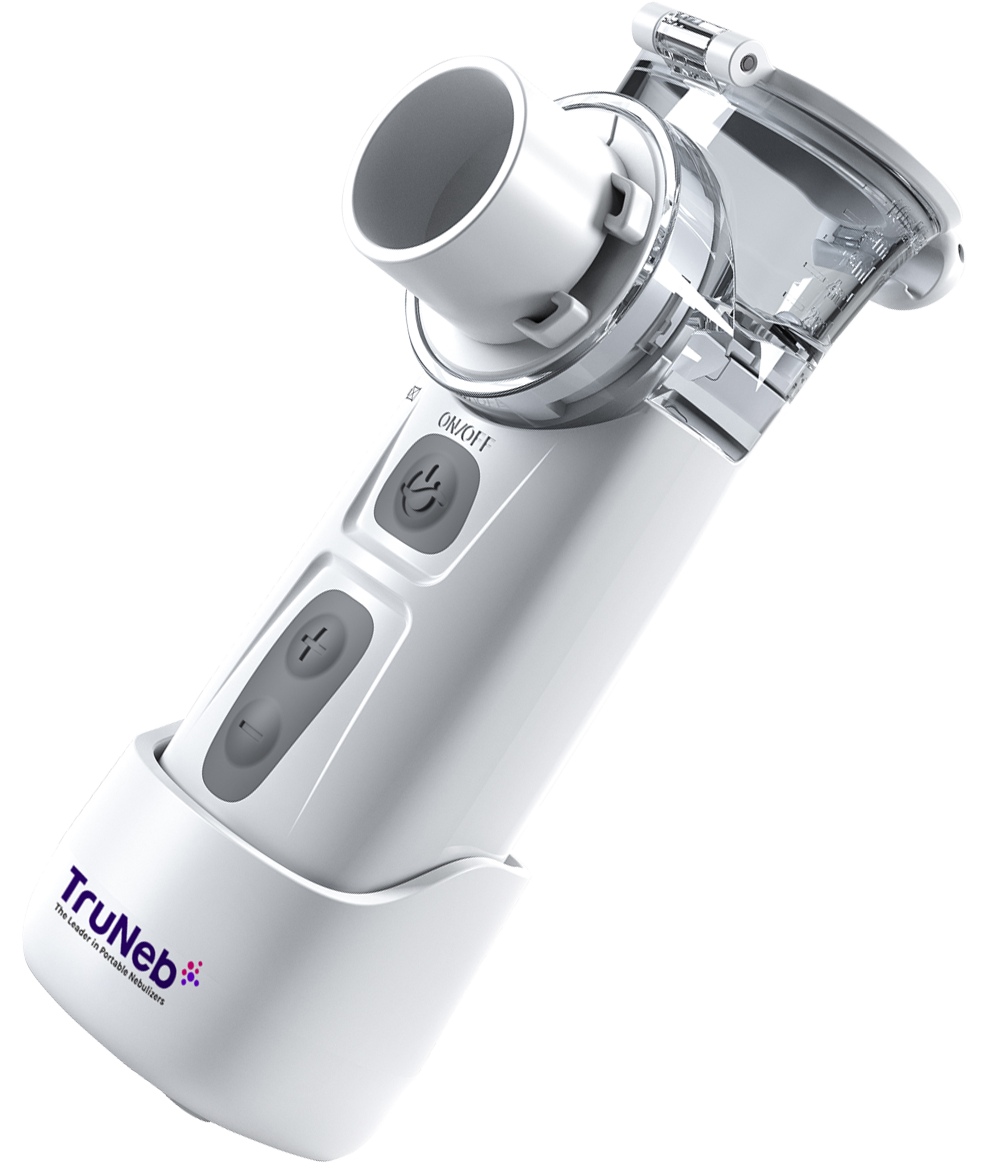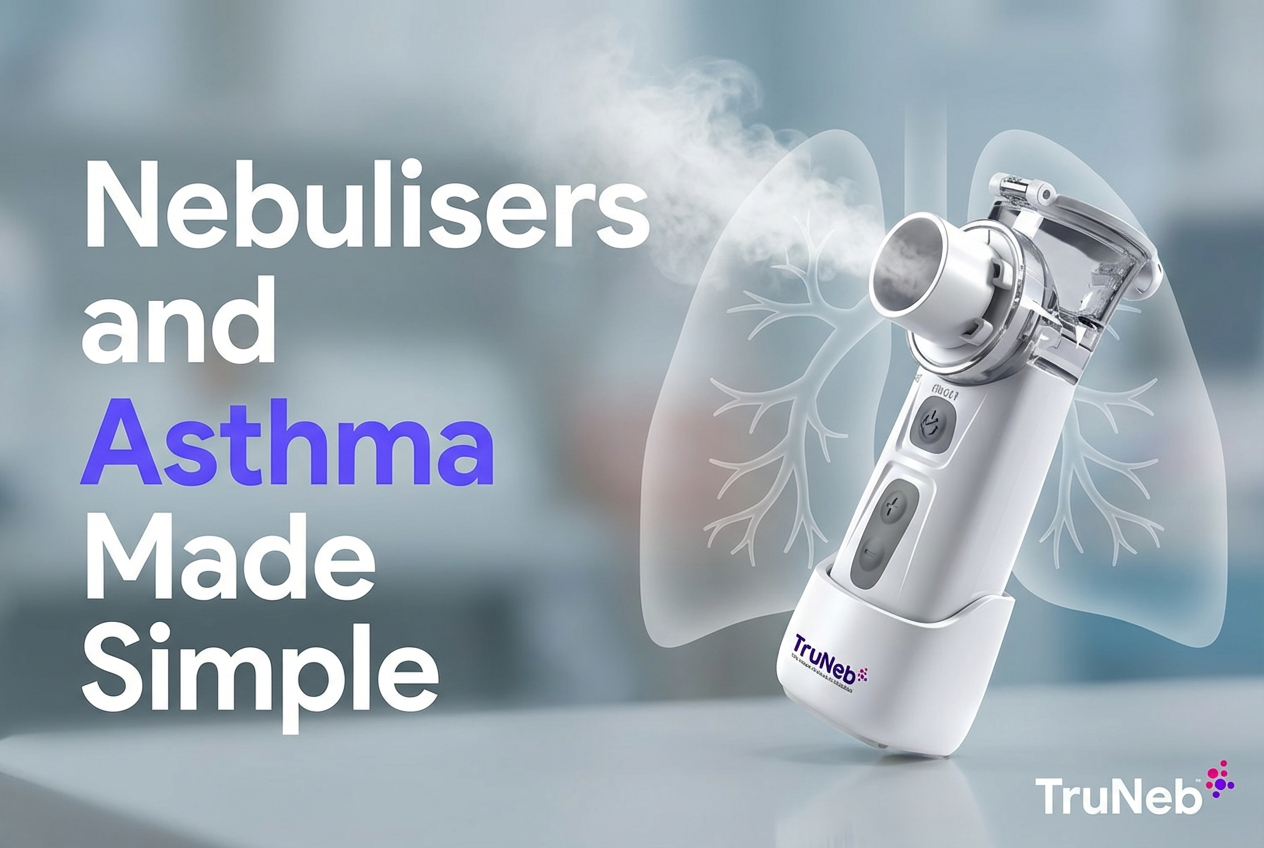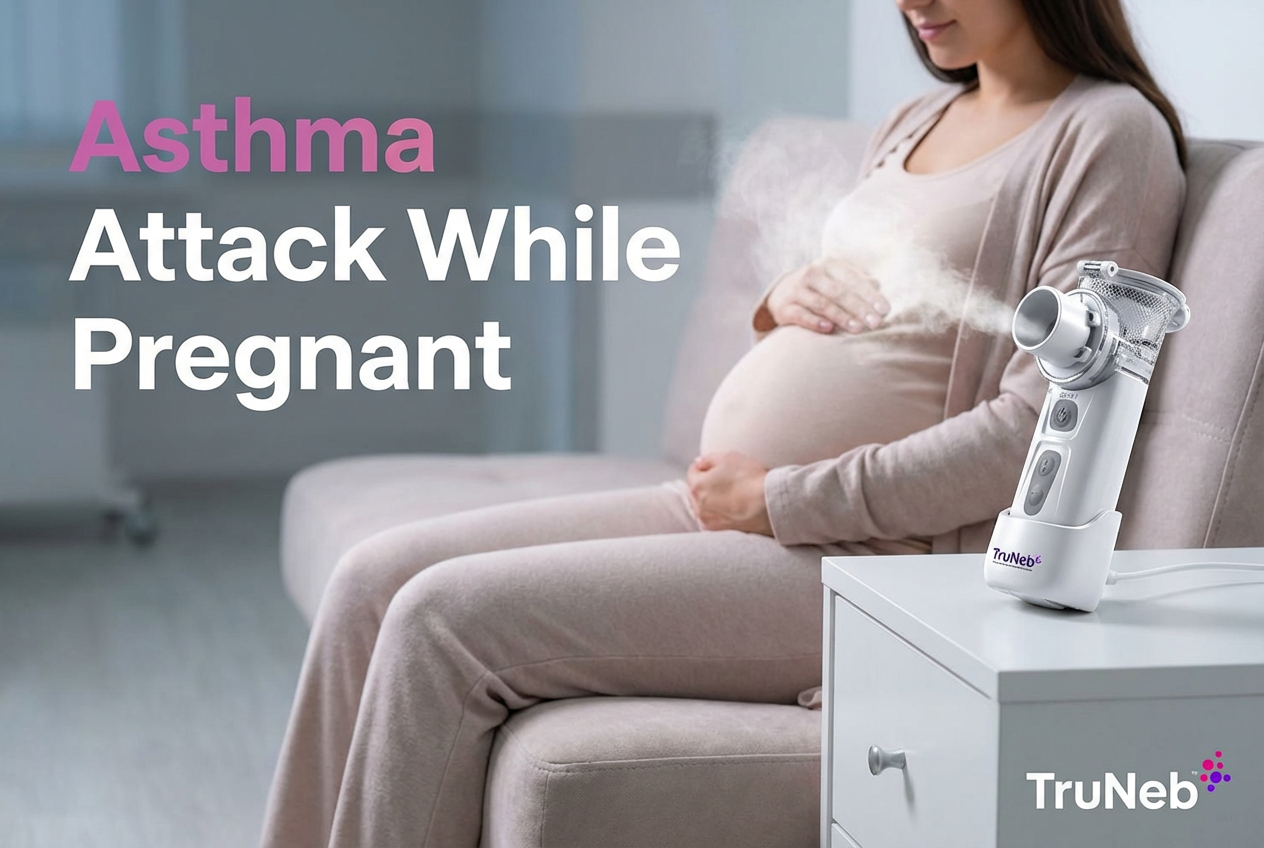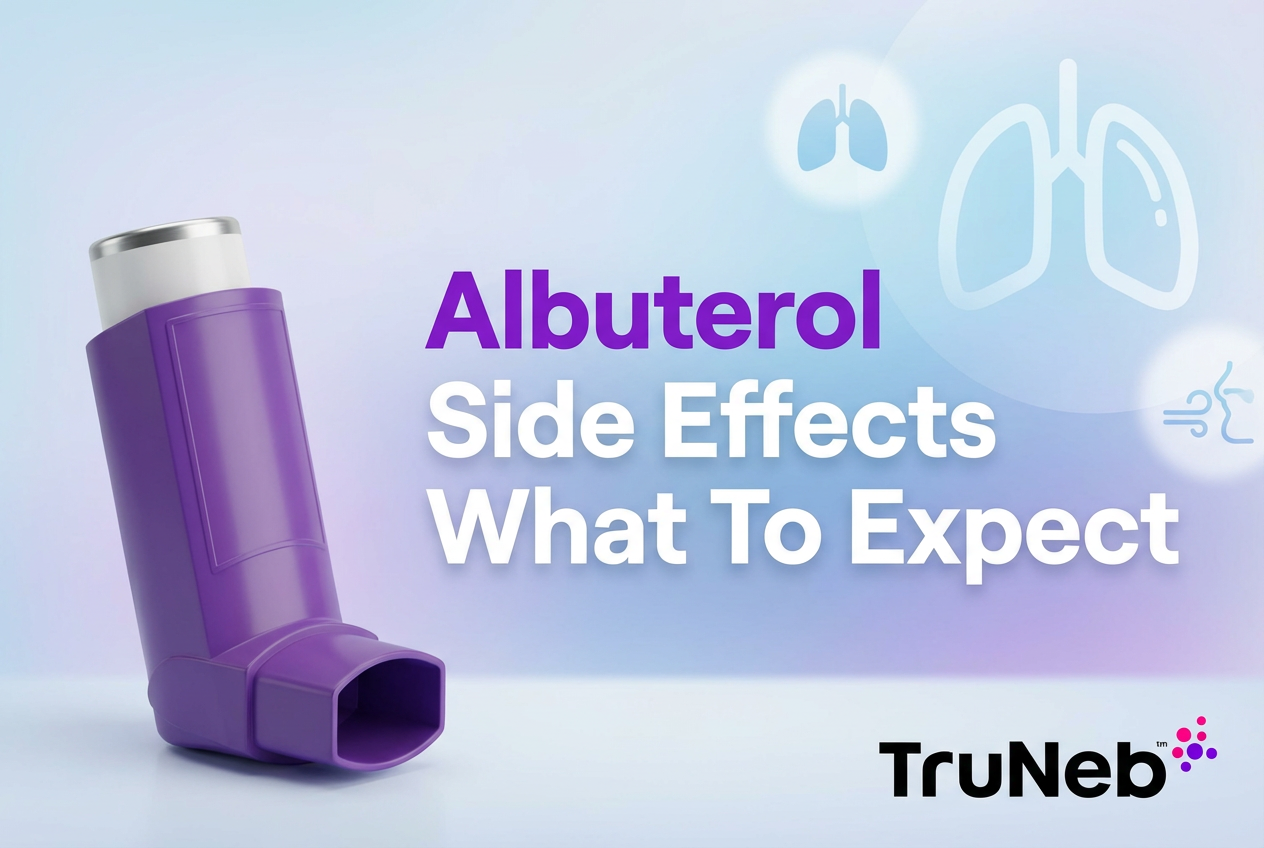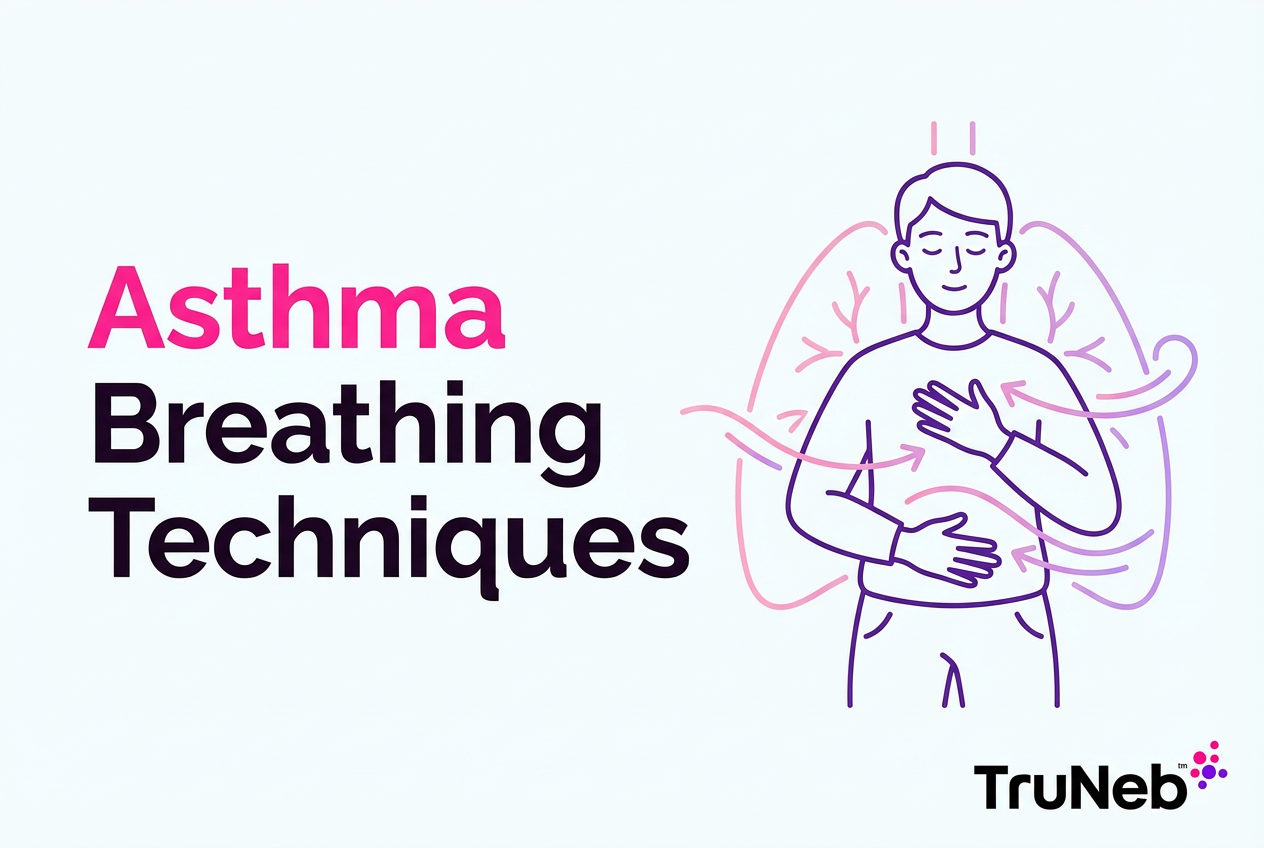On this page

What Is a Nebulizer Mask and Why Is It Used?
A nebulizer mask (sometimes called a nebulizer face mask) is a soft face mask that connects to a nebulizer machine and delivers liquid medicine as a fine mist you breathe into your lungs. It helps people with conditions like asthma, COPD, bronchitis, or cystic fibrosis. With a mask, you can breathe normally while the treatment runs. It’s different from an inhaler because you can breathe normally while the mist delivers medication over several minutes.
Nebulizers turn liquid medicine into an aerosol so it can reach deep into your airways. A mask keeps that mist near your nose and mouth, which can help more of the dose get in. This is helpful for young children, older adults, or anyone who struggles with a mouthpiece.
A nebulizer mask is a face mask for a nebulizer that delivers medication as a fine mist straight to your lungs.
A portable nebulizer like TruNeb™ can make treatments easier at home or on the go.
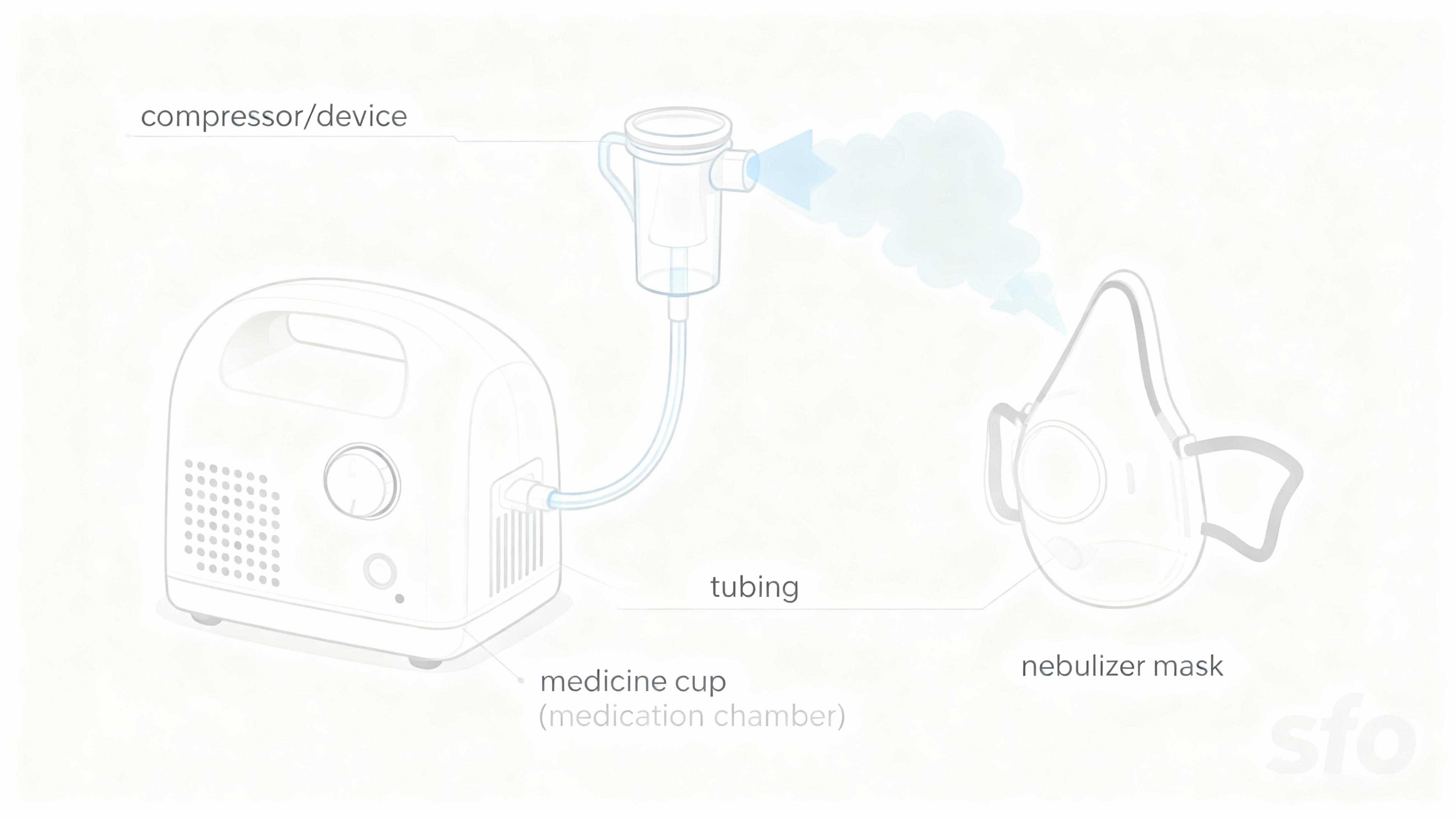
How a Nebulizer Mask Works
Here’s what happens during a treatment:
- The prescribed liquid medicine goes into the nebulizer cup.
- The device creates airflow that turns the liquid into a fine mist.
- The mist travels through the tubing into the mask.
- You breathe in through your nose and mouth while the mask gently holds the mist near your face.
Key parts you’ll use:
- Mask: fits over your nose and mouth to guide the mist in.
- Tubing: carries the mist from the device to the mask. Keep it unkinked.
- Medicine cup (medication chamber): holds the liquid dose and connects to the mask or mouthpiece.
Some masks include vent holes or a one-way valve so you can exhale safely.
If the cup is upright, tubing is straight, and the mask seals well, more medication reaches your airways.
Types of Nebulizer Masks
Adult vs Pediatric
- Adult masks are larger and shaped for a full-grown face.
- Pediatric masks are smaller for babies, toddlers, and kids so medicine doesn’t leak out the sides. Some kid masks have fun designs to reduce fear.
- Look for soft, latex-free (often silicone) materials for comfort.
Disposable vs Reusable
- Disposable masks are handy for short-term use or travel. Most are limited-use.
- Reusable masks are thicker and can be cleaned and used repeatedly. Replace them when they get stiff, cracked, or discolored.
Most nebulizer mask kits (mask and tubing kits) include the mask, tubing, and a medication cup.
Special Variants
- Some infant-friendly options include pacifier-style attachments.
- Note: A nebulizer mask delivers medicine mist, while an oxygen mask delivers oxygen. They look similar but do different jobs and aren’t interchangeable.
- You might see boxes labeled “steam inhaler” — these are NOT for breathing medications.
Choose size (adult or pediatric) and type (disposable or reusable) based on fit, comfort, and how you’ll use it.
Disposable vs Reusable: Quick Comparison
| Type | Best for | Pros | Cons |
|---|---|---|---|
| Disposable mask | Short-term use, travel, contagious illness | Convenient; no deep cleaning required | Less durable; more waste |
| Reusable mask | Regular home treatments | Durable; lower cost over time | Must be cleaned after each use and disinfected weekly |
Cleaning guidance aligned with American Lung Association and MedlinePlus recommendations; always follow your device’s manual.
How to Use a Nebulizer Mask: Step-by-Step
- Wash hands and set up your device on a flat surface.
- Measure the prescribed dose into the medicine cup.
- Connect the tubing: one end to the device (compressor), one end to the cup.
- Attach the mask to the top of the cup.
- Sit upright. Place the mask over your nose and mouth. Adjust the strap for a snug seal.
- Turn on the device. You should see or feel mist.
- Breathe slowly and normally. If you can, take a few deeper breaths during the session.
- Keep going until the mist slows and the cup is nearly empty (typically 5–10 minutes). Time varies by device and medication.
- Turn off the device. Disconnect parts and get ready to clean them.
Always follow your device’s instructions and your doctor’s guidance for your medication and treatment schedule.
Upright posture, a snug mask, and steady breaths help the medicine reach your lungs.
Tips for a Better Session
- Sit tall: An upright position helps open your airways.
- Seal the mask: Reduce gaps so less medicine escapes.
- Slow your breathing: Calm, steady breaths can help more medicine reach your lungs.
- Soothe kids: Use a story, music, or a favorite show to keep them still and relaxed.
- Finish the dose: Stopping early can reduce the benefit.
A quiet portable nebulizer like TruNeb can also reduce noise, which can help anxious children stay calm.
A snug seal and calm, steady breathing make each nebulizer session more effective.
Nebulizer Mask Troubleshooting
- No mist coming out: Check that the device is on, the cup is assembled right, and the tubing isn’t kinked. If your device uses a mesh, clean the mesh per the manufacturer’s instructions.
- Mist leaks around the edges: Adjust the strap and mask position. Try a different size mask if needed.
- The small holes on the mask: These are vent ports and are normal; they aren’t leaks.
- Child won’t keep mask on: Let them try it on a stuffed toy first. Use a fun, kid-friendly mask and distraction.
- Skin redness where the mask touches: Loosen the strap a bit, clean the mask well, and rinse off any soap residue. Add soft padding at contact points if it doesn’t block airflow.
If parts are cracked, stiff, or cloudy, it’s likely time to replace them.
Cleaning and Maintaining Your Nebulizer Mask and Tubing
- After each use: Detach the mask and medicine cup. Wash them in warm, soapy water. Rinse well with clean water. Shake off water and air-dry on a clean towel. Don’t wash the tubing unless the manufacturer allows it.
- Disinfect/sanitize regularly: At least weekly, or as your doctor advises. You can boil parts that are boil-safe or soak in a 1:3 white vinegar to water mix for about 30 minutes. Rinse and air-dry fully. Don’t boil the tubing. When in doubt, sanitize your nebulizer mask and follow the device’s manual.
- Follow manufacturer guidance: Always follow the manufacturer’s cleaning instructions for your specific mask and nebulizer.
- Store clean and dry: Keep parts in a clean, dry container or bag.
- Replace on schedule: Most users replace reusable masks and tubing about every 6 months, or sooner if you see cracks, stiffness, discoloration, or mold. Replace parts after a contagious illness. Plan for nebulizer mask replacement about every 6 months, or sooner if you see wear.
- Stay prepared: Keep a spare nebulizer mask and tubing kit on hand so you can replace worn parts without missing treatments.
Clean after each use, disinfect weekly, and replace worn parts to reduce infection risk.
Nebulizer Mask vs Mouthpiece: Which Should You Use?
Both work. The best choice depends on age, comfort, and ability.
- Mask: Great for babies, toddlers, and anyone who can’t seal lips around a mouthpiece or needs hands-free use. It can leak if the fit is poor and a small amount of medicine can land on the face.
- Mouthpiece: Good for older kids, teens, and adults who can breathe only through the mouth and hold the mouthpiece. Studies suggest mouthpieces deliver slightly more medicine into the lungs in cooperative adults.
If you can’t use a mouthpiece well, pick a mask. If you can, a mouthpiece is a bit more efficient.
Masks are best for kids or hands-free use, while mouthpieces can deliver slightly more medication in cooperative adults.
Mask vs Mouthpiece: At a Glance
| Feature | Nebulizer Mask | Mouthpiece |
|---|---|---|
| Best for | Infants, young kids, anyone who needs hands‑free use or can’t seal lips | Older kids, teens, adults who can follow directions |
| How you breathe | Normal breathing through nose and mouth | Slow, deep breaths through the mouth only |
| Pros | Hands‑free; easy to use during fatigue or sleep | Often better lung delivery in cooperative adults; no face contact |
| Cons | Can leak if fit is loose; some feel claustrophobic | Requires good mouth seal and coordination |
Evidence suggests mouthpieces may deliver a higher percentage of medication to the lungs in adults; masks remain essential for children and those unable to use a mouthpiece.
Making Nebulizer Mask Therapy Easier for Children
- Make it friendly: Use animal-themed masks or add stickers so it feels like a game.
- Show and tell: Try the mask on a stuffed animal first. Let your child touch and explore it.
- Create a routine: Same comfy chair, favorite blanket, short show or story time.
- Comfort counts: Hold your child, play calm music, and keep sessions short and steady.
- Praise small wins: Stickers or a high-five after each session can build good habits.
A quiet device and a soft, well-fitting pediatric mask can lower stress and improve cooperation.
Child-friendly masks, distraction, and praise can turn treatments into a calmer routine.
Frequently Asked Questions
Tap or click a question below to see the answer:
It delivers medicine mist from a nebulizer to your lungs to help manage conditions like asthma or COPD.
No. Masks and basic equipment are sold over the counter. The medicines used in nebulizers usually require a prescription.
No. A nebulizer mask delivers medicine mist. An oxygen mask delivers oxygen. They aren’t interchangeable.
Most users replace reusable masks and tubing about every 6 months, or sooner if worn, cracked, stiff, or after a contagious illness.
It can be very helpful when you have a condition that needs inhaled medicine. It delivers the drug deep into your airways as directed by your doctor.
No. Use pediatric-sized masks so medicine doesn’t leak and the fit is comfortable.
Safety and When to Seek Care
- Don’t share masks or tubing.
- Keep it clean: Clean after each use and disinfect/sanitize regularly.
- Follow guidance: Talk to your doctor before starting a new medication or changing your treatment plan.
- Steam warning: Steam inhalers are NOT nebulizers and aren’t for breathing medications.
- When to get urgent help: If you have severe shortness of breath, chest pain, blue lips or face, confusion, or symptoms that get worse quickly, seek emergency medical care right away.
Don’t share masks, keep parts clean, and call your doctor or seek urgent care if you have severe breathing symptoms.
Conclusion: Breathe Easier with the Right Nebulizer Mask
Choose the right mask, use it correctly, and keep it clean. Those simple steps can help your medicine reach your lungs and make each session count.
The right fit, technique, and care help every treatment count.
If you want a simple setup for home or travel, a portable nebulizer like TruNeb can help. It’s designed for easy use and pairs with adult and pediatric masks and standard replacement parts. Talk with your doctor if you have questions about your setup.
Disclaimer: This article is for informational purposes only and isn’t a substitute for professional medical advice. Always talk with your doctor about your symptoms, medications, and treatment plan.

